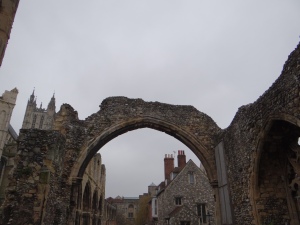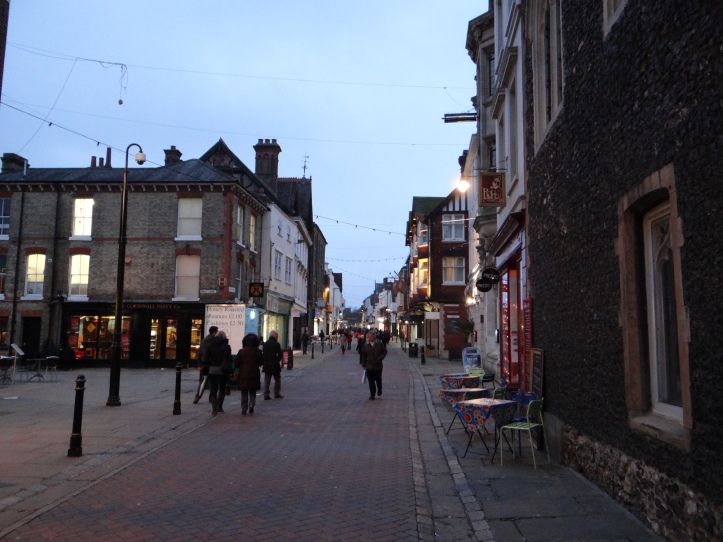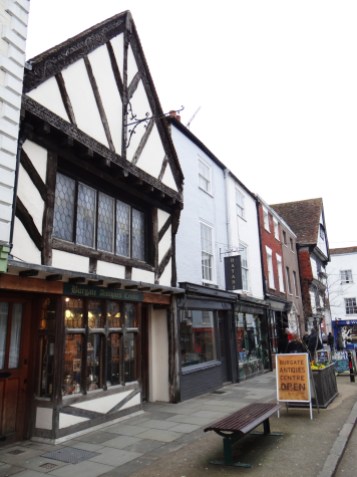

I was lucky enough to have my own “personal guide” for Canterbury in the form of my friend Adel who had visited it a couple of times before taking me. Right next to the famous Canterbury Cathedral we found the ruins of St Augustine’s Abbey. The ruins are fenced off to protect the remaining arches. St Augustine’s Abbey, the 14th richest in England at the time, was surrendered to the Crown, and its church and cloister were levelled. The rest of the abbey was dismantled over the next 15 years, although part of the site was converted to a palace.

Canterbury was first recorded as the main settlement of the Celtic tribe, the Cantiaci, which inhabited most of modern day Kent. In the 1st century AD, the Romans captured the settlement and rebuilt the city, with new streets in a grid pattern, a theatre, a temple, a forum and public baths. In the late 3rd century, to defend against attack from barbarians, the Romans built around the city an earth bank and a wall with seven gates, which enclosed an area of 53 hectares.

Parts of the city have been designated a UNESCO World Heritage Site. Many historical structures remain, including part of the city wall founded in Roman times and rebuilt in the 14th century and one of the many gates that used to surround this beautiful city. The Westgate is the largest surviving city gate in England. It survived a demolition attempt for a road-widening scheme in Victorian times.

We spent the afternoon walking through the many small shops of Buttermarket which lies in the centre of Canterbury.


The city is on the River Stour or Great Stour, of which one branch flows though the city. We It was a peacefull walk along the river and over the footbridges all along the canal.
Punts and rowed river boats are available for hire in Canterbury to navigate this river and would be lovely on a hot summers day.


This is marked as a Historic Building of Kent. The frontage is actually Victorian, it was altered in 1888 when the present facade was brought in from elsewhere. The house may have originally been built in around 1250 for the Rector of St.Alphege. The church is a little further down the street and is now Canterbury Environment Centre.



One of the most photographed historic buildings in Canterbury, the Old Weavers House is a gorgeous half-timbered building on the River Stour. The river quite literally laps at the side of the building, which currently houses a popular restaurant.
The Old Weavers House takes its name from the influx of Flemish and Hugenot weavers who settled in the area after fleeing from religious persecution during the 16th and 17th centuries. Elizabeth I granted the Flemish weavers the right to establish their businesses in Canterbury, and they are known to have used this and other similar buildings nearby.

Despite the date 1500 which can be seen prominently displayed above the door, this house probably dates back to at least the 14th century. The current building largely dates to a reconstruction in the second half of the 16th century, not the first, as you might assume by the sign! Even though it was probably built in the 14th century I still cant believe that this building is still standing!!
















Wonderful city. I love Canterbury and it has the best cathedral. So much history! Good photos on what looks like a pretty chilly day 🙂
LikeLike
Thanks! It was a bit chilly but I had a fabulous time! The Cathedral is definitely spectacular and what drew me to this city.
LikeLike
Stunning architecture indeed Janaline. It’s beautiful there and you’ve portrayed it so well! Thanks for sharing hon. 😀 *hugs*
LikeLike
Thanks Sonel! Its so good to see you are back. Hope you had a fabulous festive time!
LikeLike
Same here Janaline and though we don’t celebrate Christmas, we spend some more time with each other and in the pool. LOL!
Hope you had a lovely time as well. 😀 *hugs*
LikeLike
AAAAAAA I love all your travels!!! So many places to add to my bucket list 😀 Thanks for stopping by my blog, I can’t wait to see more photos and journeys
LikeLike
Thanks Jenny and a huge welcome to my journey! Glad I can introduce you to another couple of places to add to your travel-list!
LikeLike
What a great post, Janaline. I feel like I have visited the town!
LikeLike
Thanks for that super stunning compliment Nia! I am so glad you have joined me for these adventures!
LikeLike
Oooooh, that’s my town 🙂
LikeLike
It is such a beautiful place to live!!
LikeLike
It certainly is 🙂
LikeLike
Nice to see the streets in which Chaucer’s tale was set.
LikeLike
Such beautiful streets….ideal to inspire stories and artists
LikeLike
Ahhhh, if its on the UNESCO World Heritage List – its on our to-do list!
Great photos once again 🙂
LikeLike
Thank you!! Glad it’s on your travel list, it is a wonderful place to explore!
LikeLike